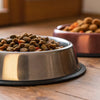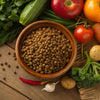Why Isn’t My Dog Eating Dry Food? Understanding the Reasons and Solutions
- Houndsy
Table of Contents
- Introduction
- Understanding the Basics of Dog Nutrition
- Common Reasons Why Dogs Refuse Dry Food
- How to Encourage Your Dog to Eat Dry Food
- Maintaining Healthy Feeding Habits
- Conclusion
Introduction
As dog lovers, we often find ourselves puzzled when our furry friends suddenly refuse to eat their dry food. Did you know that approximately 10% of pet owners report their dogs being picky eaters at some point in their lives? This can lead to significant concern for our pets' health and wellbeing. If you've found yourself asking, "Why isn’t my dog eating dry food?" you're not alone.
In this blog post, we'll explore the many reasons why our dogs may turn their noses up at kibble. Understanding these causes is essential not only for ensuring our pets receive proper nutrition but also for recognizing when a visit to the veterinarian is necessary. We’ll delve into common medical and behavioral issues, tips for making dry food more appealing, and suggestions for maintaining a healthy feeding routine. By the end of this article, you will be equipped with actionable insights to address your dog's eating habits, ensuring that mealtime becomes a joyful experience for both you and your pup.
Let’s embark on this journey together, reflecting on our feeding routines and discovering practical solutions to enhance our dogs' dining experience.
Understanding the Basics of Dog Nutrition
Before we dive into the reasons why a dog may refuse dry food, it’s essential to grasp the fundamentals of canine nutrition and feeding practices. Dogs, like humans, require a balanced diet to thrive. This includes proteins, fats, carbohydrates, vitamins, and minerals. Dry food, or kibble, is designed to provide a complete diet, and it is often favored for its convenience and shelf stability.
The Importance of Hydration
One crucial aspect of a dog’s diet is hydration. Dogs need access to fresh water at all times, especially when consuming dry food, which can be dehydrating. Lack of hydration can lead to health issues, including kidney problems and urinary tract infections. If your dog isn’t drinking enough water, they may be reluctant to eat dry food.
Common Dry Food Ingredients
Understanding the ingredients in your dog’s kibble is also vital. High-quality dry food should contain meat as the primary ingredient, along with grains, vegetables, and supplements. If your dog is sensitive to certain ingredients or if the food isn’t palatable, they may avoid it altogether.
Reflective Question
Have you checked the ingredient list of your dog’s dry food recently? Sometimes, a quick look at the kibble's contents can reveal why your dog might not be interested in eating.
Common Reasons Why Dogs Refuse Dry Food
1. Medical Issues
Dental Problems
One of the most common medical reasons for a dog refusing to eat dry food is dental pain. Conditions such as periodontal disease, tooth decay, or oral injuries can cause significant discomfort. If your dog shows signs of pain while eating or avoids their food entirely, a veterinary visit is warranted.
Gastrointestinal Upset
Nausea and gastrointestinal issues can also lead to a lack of appetite. Symptoms such as vomiting, diarrhea, or bloating may accompany this condition. If your dog has recently eaten something they shouldn’t have or if there are changes in their bowel movements, consult your vet.
Other Health Conditions
There are various health issues that can affect a dog’s appetite, including infections, kidney disease, or even cancer. If your dog has lost weight or shows other signs of illness, seek veterinary advice promptly.
2. Behavioral Factors
Picky Eaters
Some dogs are naturally picky eaters. They may have developed preferences for certain flavors or textures, leading them to refuse dry food that doesn't meet their standards. This behavior can be exacerbated by overindulgence in treats or table scraps.
Stress and Anxiety
Dogs are sensitive creatures, and changes in their environment or routine can lead to stress and anxiety. Loud noises, new pets, or changes in the household can cause a dog to lose interest in their meals.
Kibble Fatigue
Just like humans, dogs can get bored with their food. If you’ve been feeding the same dry food for an extended period, your dog might simply be tired of it. Rotating flavors or brands can help keep mealtime exciting.
3. Environmental Influences
Bowl Placement
Sometimes, the location of a dog’s food bowl can affect their willingness to eat. If the bowl is in a noisy or busy area, your dog may feel uncomfortable eating there. Additionally, if their bowl is difficult to access or has an unpleasant odor, it can deter them from eating.
Temperature and Freshness
Dry food that has been stored improperly can lose its appeal. Ensure that kibble is kept in a cool, dry place and check the expiration date. If the food smells off or is stale, your dog will likely refuse to eat it.
How to Encourage Your Dog to Eat Dry Food
1. Make It More Appetizing
If your dog isn’t eating dry food, consider enhancing its appeal. Here are some tips:
- Add Water or Broth: Pouring warm water or low-sodium chicken broth over kibble can make it more enticing and easier to chew.
- Mix in Toppers: Adding healthy toppers like canned pumpkin, plain yogurt, or small amounts of fruits can enhance flavor and texture.
2. Adjust the Feeding Routine
Sometimes, simply changing when and how you feed your dog can make a difference.
- Regular Feeding Times: Establish a routine by feeding your dog at the same time each day. This helps create anticipation and encourages them to eat.
- Portion Control: Instead of leaving food out all day, offer meals in controlled portions. This can motivate dogs to eat when food is available.
3. Provide a Comfortable Eating Environment
Ensure your dog feels safe and comfortable while eating.
- Quiet Space: Move their bowl to a quieter area away from distractions and noise.
- Non-Slip Bowls: Consider using non-slip bowls that stay in place while your dog eats, reducing frustration.
4. Consult Your Veterinarian
If your dog continues to refuse dry food or shows signs of distress, it's crucial to consult your veterinarian. They can help identify any underlying health issues and recommend appropriate treatments or dietary changes.
Maintaining Healthy Feeding Habits
1. Monitor Weight and Health
Keep an eye on your dog’s weight and overall health. Regular vet check-ups can help catch any potential issues early.
2. Invest in Quality Kibble
Choosing high-quality, nutritious dry food can make a significant difference. Look for brands that prioritize natural ingredients and avoid fillers.
3. Explore Feeding Innovations
Innovative feeding solutions like the Houndsy Kibble Dispenser can enhance your dog’s feeding experience. With features that provide perfect portion control and ergonomic design, these dispensers make mealtime convenient and aesthetically pleasing. Explore the Houndsy Kibble Dispenser here.
Conclusion
Understanding why your dog isn’t eating dry food is crucial for their health and happiness. Whether it's a medical issue, behavioral factors, or environmental influences, there are various strategies to encourage your dog to eat their kibble. By being proactive and attentive to your dog’s feeding habits, you can help ensure they receive the nutrition they need.
Reflecting on your dog's meal routine can lead to positive changes that not only enhance their eating experience but also strengthen your bond. If you’re looking for a stylish and functional solution to elevate mealtime, consider the Houndsy Kibble Dispenser, designed to simplify your dog’s feeding experience.
FAQ
Q1: How long can a dog go without eating?
A1: While dogs can survive for a few days without food, it's essential to seek veterinary care if your dog hasn’t eaten for more than 24 hours or shows signs of illness.
Q2: Is it normal for my dog to refuse food occasionally?
A2: Yes, it can be normal for dogs to have off days. However, if refusal persists, it’s crucial to investigate potential underlying issues.
Q3: What should I do if my dog refuses to eat all food types?
A3: If your dog refuses to eat both dry and wet food, consult your veterinarian to rule out health problems.
Q4: Can I mix dry food with wet food?
A4: Yes, mixing dry food with wet food can enhance flavor and texture, making meals more appealing for picky eaters.
Q5: How can I tell if my dog is dehydrated?
A5: Signs of dehydration include dry gums, excessive panting, lack of energy, and skin that doesn’t spring back when pinched. Always provide fresh water and consult your vet if you notice these symptoms.
By taking the time to understand your dog’s eating habits and making the necessary adjustments, you can help ensure they enjoy their meals and maintain a healthy lifestyle.












